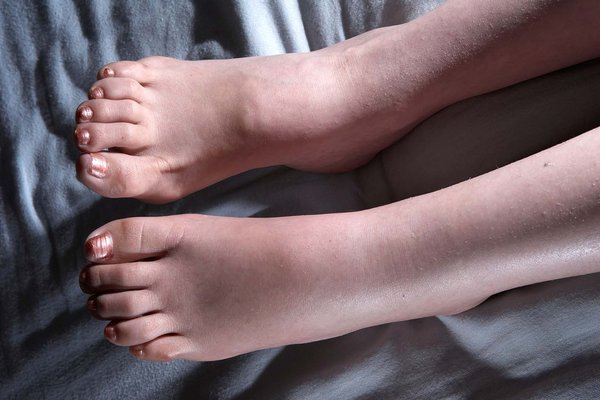Here’s something you might not expect to hear from a doctor: your feet could be trying to save your life. That’s right—those overlooked appendages at the bottom of your body may be the very things telling you your internal organs are in distress.
The human body is a fascinating, interconnected system. When something goes wrong internally—especially with your heart, kidneys, liver, or nervous system—it doesn’t always show up where you’d expect. In fact, one of the most surprising places early warning signs show up is on your feet.
So how do you know when it’s time to take your foot symptoms seriously? There are three major signs you should never ignore. If you notice any of them, a visit to the emergency room may be the smartest move you’ll ever make.
🦶 Sign #1: Swollen Feet and Ankles

Let’s talk about swelling—also known as edema. It’s normal to have a little puffiness after a long flight or a hot day. But when swelling in your feet or ankles becomes persistent, painful, or unexplained, it can signal something far more serious.
What it could mean:
- Kidney dysfunction: When your kidneys aren’t filtering fluids properly, that excess fluid pools in the lower extremities.
- Heart failure: A weakened heart struggles to circulate blood efficiently, leading to fluid build-up.
- Liver disease: A failing liver can disrupt protein production, which also causes fluid to accumulate.
If your shoes suddenly feel tight, your feet look puffy, and the swelling doesn’t go away overnight, don’t brush it off. It could be your organs crying out for help.
🎨 Sign #2: Discoloration or Skin Changes
Ever looked down and noticed your feet turning colors they shouldn’t be? A bluish, purple, or yellow tint is not just a cosmetic issue—it could be a red flag for internal distress.
Here’s what those colors may mean:
- Blue or purple (Cyanosis): Often linked to poor circulation or a lack of oxygen in the blood. Could be related to heart or lung issues.
- Yellowing (Jaundice): If your toes, soles, or toenails look yellow, your liver may be in trouble. Conditions like hepatitis or cirrhosis often show signs here first.
Even small shifts in color or texture could be your body waving a red flag. Skin changes are your body’s silent language—it’s time to start listening.
⚡ Sign #3: Persistent Pain, Numbness, or Tingling
A little foot fatigue after a long day is normal. But chronic pain, burning, or numbness? That’s a different story. These symptoms often stem from compromised nerve or blood vessel function, and they may be linked to far more serious internal issues.
Video : Top 10 Early Warning Signs of Sepsis
What it could point to:
- Diabetes: Elevated blood sugar damages nerves over time. The result? A condition called peripheral neuropathy, often first felt in the feet.
- Cardiovascular issues: Restricted blood flow due to clogged arteries or high blood pressure can cause tingling and discomfort.
- Kidney failure: Toxin buildup from failing kidneys can also impact nerve endings in your feet.
Don’t wait until the pain spreads or becomes unbearable. The earlier you act, the better your odds of catching—and treating—what’s really going on inside.
🧠 Why the Feet? Why Not the Chest or Back?
Great question. Think of your body as a plumbing and wiring system. Your feet are the farthest points from your heart, meaning they’re the first to feel the effects of circulation problems, poor oxygenation, and nerve damage.
It’s like seeing a warning light flash on the dashboard of your car. The problem might be under the hood, but the alert pops up on the dashboard. Your feet are that dashboard.
🚑 When Should You Go to the Emergency Room?
If you’re experiencing any of these three signs—especially if they appear suddenly, worsen quickly, or are accompanied by other symptoms like chest pain, dizziness, or shortness of breath—you need to act fast.
It’s better to go and find out it’s nothing than to wait and realize it was something serious all along.
Here’s a quick checklist for when to seek help:
- Swelling that lasts more than a few days
- Sudden foot color change, especially blue or yellow
- Intense burning or numbness that disrupts sleep
- Sores that don’t heal (especially in diabetics)
- Skin that’s shiny or tight, which may indicate fluid retention

🛡️ How to Stay Ahead of Serious Issues
While it’s essential to recognize warning signs, prevention is still your best defense. Here are some quick tips to support your internal organs—and keep your feet symptom-free:
- Hydrate wisely: Dehydration stresses the kidneys.
- Get moving: Exercise boosts circulation and heart health.
- Watch your sugar and salt: These directly affect kidney, liver, and heart function.
- Don’t ignore foot care: Clean, inspect, and moisturize your feet daily.
- Get regular checkups: Early detection can save lives.
🦶 Your Feet Might Be Telling a Bigger Story
Most of us don’t think about our feet unless they hurt. But in reality, your feet are full of clues about what’s happening deeper inside. Swelling, discoloration, and nerve sensations may seem minor, but they could be early signs of major organ issues.
Think of your feet as your personal warning system. Pay attention to them, and you might just catch a serious condition before it becomes life-threatening.
Video : Don’t Ignore These Early Symptoms of Parasites In Your Body
Final Thoughts: Listen to What Your Feet Are Saying
Our bodies are constantly sending signals—we just have to know where to look. Your feet, of all places, are rich in these hidden signs. Don’t wait for a dramatic symptom to take action.
If you notice three key signs—persistent swelling, skin discoloration, or unusual sensations—it’s time to take it seriously. Your feet might be uncomfortable, but your organs might be in danger.
So the next time you kick off your shoes, take a moment. What are your feet telling you? It could be the wake-up call your health needs.


